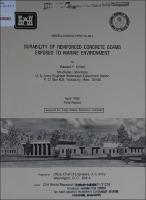Please use this identifier to cite or link to this item:
https://hdl.handle.net/11681/10989| Title: | Durability of reinforced concrete beams exposed to marine environment |
| Authors: | O'Neil, Edward F. |
| Keywords: | Concrete deterioration Concrete testing Concrete beams Reinforced concrete beams Weathering |
| Publisher: | Structures Laboratory (U.S.) Engineer Research and Development Center (U.S.) |
| Series/Report no.: | Miscellaneous paper (U.S. Army Engineer Waterways Experiment Station) ; SL-82-1. |
| Description: | Miscellaneous Paper Abstract: A study was begun in 1950 to determine the effects of severe natural weathering on stressed, reinforced concrete beams of various compositions and degrees of stress. The objectives of the study were to obtain information on the long-term weathering of air-entrained and nonair-entrained concrete beams containing steel of different compositions and types of deformation and having different levels of stress in the steel that would cause varying degrees of cracking of the concrete. The beams were fabricated, cured, and loaded at the U. S. Army Engineer Waterways Experiment Station (WES) in 1951, then shipped to Eastport, Maine, and placed on the beach at the natural weathering exposure station on the south side of Treat Island, Cobscock Bay, Eastport, and Lubec. The beams were subjected to twice daily tidal cycles exposing them to wetting under considerable head and drying to surface dry conditions. In addition, during the winter months, the beams were subjected to cycles of freezing and thawing with each tide when the air temperature was at or below -2.2°C. The beams were inspected annually during the exposure period and evaluated by a team of inspectors to determine the degree of deterioration. Maximum crack widths were also measured annually beginning in 1956 and continuing until 1975, when the exposure period was concluded after 25 years of weathering. At the end of the exposure period, 13 of the 82 beams still remained at the testing site. (By 1956, 60 of the beams, all fabricated from nonair-entraining concrete, had been destroyed by freezing and thawing.) Of the 13 beams remaining in 1975, 11 were returned to the laboratory for laboratory testing. The results of the exposure study and the laboratory investigation indicated, among other findings, that stressing the steel to various levels of stress over the exposure period did not adversely reduce the moment carrying capacity of the beams even though rusting and spalling had occurred; corrosion to the steel could not be found at any flexural crack smaller than 0.40 mm; and sustained levels of stress to the reinforcing did not reduce the tensile properties of the steel to below acceptable standards. |
| Rights: | Approved for public release; distribution is unlimited. |
| URI: | http://hdl.handle.net/11681/10989 |
| Appears in Collections: | Miscellaneous Paper |
Files in This Item:
| File | Description | Size | Format | |
|---|---|---|---|---|
| MP-SL-82-1.pdf | 3.74 MB | Adobe PDF |  View/Open |